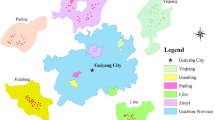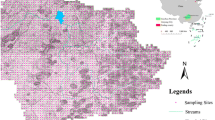Abstract
Karst landforms are special geological structures in southwestern China that are closely related to local ecological environments and human activity. This study focuses on the Wuming District, Nanning City, Guangxi Province, China, to explore the influence of different factors on the organic carbon storage and density characteristics of typical karst landform soils in the Wuming area. A multi-objective geochemical investigation was conducted from five perspectives: geological age, rock type, landform type, soil type, and land-use type. Surface and deep soil organic carbon (SOC) content data were obtained, and the organic carbon density and storage were calculated for the study area. The results showed significant vertical heterogeneity in soil organic carbon content, with carbon storage increasing with depth, indicating distinct carbon sink characteristics (p < 0.01). Overall soil organic carbon density was highest in the Devonian period among the different geologic ages (up to 3.92 kg/m2 in the surface layer), with acidic rocks resulting from ancient volcanic activity showing the highest organic carbon density among the lithological classifications (4.09 kg/m2). Karst landform soils, primarily limestone, had a higher organic carbon density than that of other terrains, particularly in carbonate rocks intermingled with clastic rocks. Despite the limited distribution of Bog soil within the study area, they exhibited the greatest carbon sequestration capacity among all evaluated soil types, with a soil organic carbon Density of 4.81 kg/m2. The predominant land-use type was arable land, encompassing a vast expanse dedicated to dryland farming—72.66% of the study area's total extent—which accounted for the highest organic carbon storage, estimated at 3.14 Tg. Conversely, paddy fields demonstrated superior organic carbon density. Collectively, these results illuminate the intricate interactions among variables that affect organic carbon storage and density in the soils of karst landscapes within the study area. This contributes to a deeper understanding of carbon cycling and its management within karst ecosystems.










Similar content being viewed by others
Availability of data and materials
The datasets used or analyzed during the current study are available from the corresponding author on reasonable request. All data generated or analyzed during this study are included in this published article.
References
Bartłomiej W, Tahsin KNM, Adnan M, Marcin P, Jan F (2023) Soil carbon storage in unreclaimed post mining sites estimated by a chronosequence approach and comparison with historical data. CATENA 220:106664
Bausenwein U, Gattinger A, Langer U, Embacher A, Hartmann HP, Sommer M, Schloter M (2008) Exploring soil microbial communities and soil organic matter: Variability and interactions in arable soils under minimum tillage practice. Appl Soil Ecol 40(1):67–77. https://doi.org/10.1016/j.apsoil.2008.03.006
Boitsova LV, Neprimerova SV, Zinchuk EG (2023) Sequestration of organic carbon in sod-podzolic sandy loam soil. Russian Agric Sci. 49(2):184–188
Chen M, Gao J-y, Chen H-l, Jing J, Li R (2023) Elevation, bedrock exposure, land use, interbedded limestone and clastic rock, and vegetation coverage dominate the spatiotemporal variability of soil erosion in karst basin. J Mountain Sci 20:2519–2535
Christensen BT (2001) Physical fractionation of soil and structural and functional complexity in organic matter turnover. Eur J Soil Sci 52(3):345–353
Deng J, Wang CM, Li GJ, Zhou DQ (2019) The theory of composite metallogenic system: key of recovering metallogenic mystery in the SW Tethys. Acta Petrol Sin 35(5):1303–1323. https://doi.org/10.18654/1000-0569/2019.05.01
Du YS, Gong YM, Zeng XW, Huang HW, Yang JH, Zhang Z, Huang ZQ (2008) Devonian Frasnian-Famennian transitional event deposits of Guangxi, South China and their possible tsunami. Origin Sci China Ser D Earth Sci 51:1570–1580
Engineering Geology (1885) Science, 5(112).
Falahatkar S, Hosseini SM, Mahiny AS, Ayoubi S, Wang S-q (2014) Soil organic carbon stock as affected by land use/cover changes in the humid region of northern Iran. J of Mountain Sci 11:507–518
Greene RSB, Tongway DJ (1989) The significance of (surface) physical and chemical properties in determining soil surface condition of Red earth in rangelands. Soil Res 27:213–225
Guangyu Z, Zhouping S, Xinzhi H, Lei D (2021) Effects of land use changes on soil organic carbon, nitrogen and their losses in a typical watershed of the Loess Plateau China. Ecol Indicat 133:108443
Gulde S, Chung H, Amelung W, Chang C, Six J (2008) Soil carbon saturation controls labile and stable carbon pool dynamics. Soil Sci Soc Am J 72(3):605–612
Han F, Yang ZP, Liu XY, Di F (2011) Impact assessment and protection of outstanding landscape integrity in a natural heritage site: Fairy Valley, Kanas Nature Reserve, Xinjiang, China. J Mountain Sci 8(1):46–52. https://doi.org/10.1007/s11629-011-2067-x
Hedges JI, Oades JM (1997) Comparative organic geochemistries of soils and marine sediments. Org Geochem 27:319–361
Huang F, Wei XM, Zhu TB, Luo ZAX, Cao JH (2021) Insights into distribution of soil available heavy metals in karst area and its influencing factors in Guilin, Southwest China. Forests. https://doi.org/10.3390/f12050609
Huang X, Zhang Z, Zhou Y, Wang X, Zhang J, Zhou X (2021) Characteristics of soil organic carbon under different karst landforms. Carbonat Evaporites 36:40
Karchegani PM, Ayoubi S, Mosaddeghi MR, Honarjoo N (2012) Soil organic carbon pools in particle-size fractions as affected by slope gradient and land use change in hilly regions, western Iran. J Mountain Sci 9:87–95
Kuhn NJ, Hoffmann T, Schwanghart W, Dotterweich M (2009) Agricultural soil erosion and global carbon cycle: controversy over? Earth Surf Process Landf 34(7):1033–1038
Lal R (2004) Soil carbon sequestration impacts on global climate change and food security. Science 304:5677
Li Y (2021) Research on the characteristics of karst tourism geological resources and environmental protection in China Southwest Region. J Sociol Ethnol 3(5):154–159
Mehler K, Schoning I, Berli M (2014) The importance of rock fragment density for the calculation of soil bulk density and soil organic carbon stocks. Soil Sci Soc Am J 78(4):1186–1191. https://doi.org/10.2136/sssaj2013.11.0480
Melillo JM, Steudler PA, Aber JD, Newkirk K, Lux H, Bowles FP, Morrisseau S (2002) Soil warming and carbon-cycle feedbacks to the climate system. Science 298(5601):2173–2176
Min Z, Xiaoxiong B, Ying W, Yan L, Yongxing C, Sile H, Xuan Y (2023) Soil microbial trait-based strategies drive the storage and stability of the soil carbon pool in Robinia pseudoacacia plantations. CATENA 222:106894
Ming-xiang MEI, Yong-Sheng MA, Deng Jun CHU, Han-min LIU et al (2005) Carboniferous to Permian sequence stratigraphic framework of the Yunnan-Guizhou-Guangxi basin and its adjacent areas and global correlation of third-order sea-level change. Geol China 32:13–24
Piao HC, Wu YY, Hong YT, Yuan ZY (2000) Soil-released carbon dioxide from microbial biomass carbon in the cultivated soils of karst areas of southwest China. Biol Fertil Soils 31(5):422–426. https://doi.org/10.1007/s003749900189
Post WM, Kwon KC (2000) Soil carbon sequestration and land-use change: processes and potential. Glob Change Biol 6(3):317–327
Shahriari A, Khormali F, Kehl M, Ayoubi Sh, Welp F (2011) Effect of a long-term cultivation and crop rotations on organic carbon in loess derived soils of Golestan Province, Northern Iran.
Shi XZ, Wang K, Warner ED, Yu DS, Wang HJ, Yang RW, Shi DM (2007) Relationship between soil erosion and distance to roadways in undeveloped areas of China. CATENA 72(2):305–313
Smith P (2005) An overview of the permanence of soil organic carbon stocks: influence of direct human-induced, indirect and natural effects. Eur J Soil Sci 56(5):673–680
Song CC, Yan BX, Wang YS, Wang YY, Lou YJ, Zhao ZC (2003) Fluxes of carbon dioxide and methane from swamp and impact factors in Sanjiang Plain, China. Chin Sci Bull 48(24):2749–2753. https://doi.org/10.1360/03wd0250
Tu JQ, Chen JP, Zhang DJ, Cheng KM, Chen JJ, Yang ZM (2012) A petrographic classification of macerals in lacustrine carbonate source rocks and their organic petrological characteristics: a case study on Jiuxi basin. NW China Acta Petrologica Sinica 28(3):917–926
Wang S-J, Li R-L, Sun C-X, Zhang D-F, Li F-Q, Zhou D-Q, Xiong K-N, Zhou Z-F (2004a) How types of carbonate rock assemblages constrain the distribution of karst rocky desertified land in Guizhou Province, PR China: phenomena and mechanisms. Land Degrad Dev 15:123–131
Wang X, Zhou J, Qiu J, Gao J (2004b) Geochemistry of the Meso-to Neoproterozoic basic–acid rocks from Hunan Province, South China: implications for the evolution of the western Jiangnan orogen. Precambrian Res 135:79–103
Wang SQ, Yu GR, Zhao QJ, Niu D, Chen QM, Wu ZF (2005) Spatial characteristics of soil organic carbon storage in China’s croplands. Pedosphere 15(4):417–423
Wang K, Zhang C, Chen H, Yue Y, Zhang W, Zhang M, Qi X, Zhiyong F (2019) Karst landscapes of China: patterns, ecosystem processes and services. Landsc Ecol 34:2743–2763
Wang T, Zhu Z, Wu W (2002) Sandy desertification in the north of China. Sci China Ser D Earth Sci 45(1).
Weissert LF, Salmond JA, Schwendenmann L (2016) Variability of soil organic carbon stocks and soil CO2 efflux across urban land use and soil cover types. Geoderma 271:80–90. https://doi.org/10.1016/j.geoderma.2016.02.014
Wenjie L, Yamin J, Qiu Y, Huai Y, Yide L, Zhaolei L, Zhenghong T (2021) Spatial distribution and stability mechanisms of soil organic carbon in a tropical montane rainforest. Ecol Indicat 129:107965
Witt C, Cassman KG, Olk DC, Biker U, Liboon SP, Samson MI, Ottow JCG (2000) Crop rotation and residue management effects on carbon sequestration, nitrogen cycling and productivity of irrigated rice systems. Plant Soil 225:263–278
Xiong X, Grunwald S, Corstanje R, Yu C, Bliznyuk N (2016) Scale-dependent variability of soil organic carbon coupled to land use and land cover. Soil till Res 160:101–109. https://doi.org/10.1016/j.still.2016.03.001
Yang XM, Song ZL, Van Zwieten L, Sun XL, Yu CX, Wang WQ, Wang HL (2021) Spatial distribution of plant-available silicon and its controlling factors in paddy fields of China. Geoderma. https://doi.org/10.1016/j.geoderma.2021.115215
Yao HB, Lv WD, Geng YS, Wang F (2016) Research of prediction method on geology faults of karst area in southwest of Guangxi Province. Paper presented at the Transportation Research Congress (Trc), Beijing, CHINA.
Zhang ZM, Zhou YC, Wang SJ, Huang XF (2017) Soil organic carbon density spatial distribution and influencing factors in a karst mountainous basin. Pol J Environ Stud 26(5):2363–2374. https://doi.org/10.15244/pjoes/69283
Zhao J, Li C, Chuanhao L, Deng L, Liu G, Fan M (2022) Acidic condition accelerates cation release from purple rock in Southwestern China. Sci Rep 12:2045–2322
Zhenming Z, Yunchao Z, Shijie W, Xianfei H (2018) Spatial distribution of stony desertification and key influencing factors on different sampling scales in small karst watersheds. Int J Environ Res Public Health 15(4):743
Funding
This work was supported by the National Multi-Purpose Regional Geochemical Survey (NMPRGS) Project (GZTR20060115, GZTR20070107, GZTR20080110, DD20160327-03); Guangxi Key Mineral Resources Deep Exploration Talent Highland ((GuiZuTong) [2019] No.85).
Author information
Authors and Affiliations
Contributions
Jie Li and Xinying Ke conducted formal analysis, wrote the original draft, and were involved in funding acquisition. Xinyu Wang and Lei Wang contributed to formal analysis, investigation, and methodology. Jie Luo provided conceptualization, led the writing, and oversaw the review and editing. Siyao Feng focused on methodology, formal analysis, and participated in the writing and review process.All authors reviewed the manuscript.
Corresponding authors
Ethics declarations
Competing interests
None of the authors have any competing interests.
Ethical approval
Not applicable. This work did not describe experiments with animals, human subjects, or human tissue samples.
Consent to participate
Not applicable. This work did not describe experiments with animals, human subjects, or human tissue samples.
Consent for publication
The manuscript entitled, “Analysis of SOC Composition Characteristics and Causes in Wuming Region Karst Landforms, Nanning, Guangxi Province, China” is prepared in accordance with the Guide for Authors available on the journal’s website and it has not been published elsewhere in part or in its entirety. All authors attest to the validity of its contents, and agree to its submission.
Additional information
Publisher's Note
Springer Nature remains neutral with regard to jurisdictional claims in published maps and institutional affiliations.
Rights and permissions
Springer Nature or its licensor (e.g. a society or other partner) holds exclusive rights to this article under a publishing agreement with the author(s) or other rightsholder(s); author self-archiving of the accepted manuscript version of this article is solely governed by the terms of such publishing agreement and applicable law.
About this article
Cite this article
Li, J., Ke, X., Wang, X. et al. Analysis of soil organic carbon composition characteristics and causes in Wuming region Karst landforms, Nanning, Guangxi Province, China. Environ Earth Sci 83, 349 (2024). https://doi.org/10.1007/s12665-024-11660-9
Received:
Accepted:
Published:
DOI: https://doi.org/10.1007/s12665-024-11660-9




